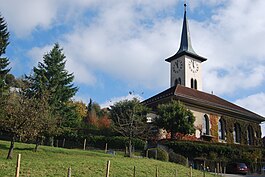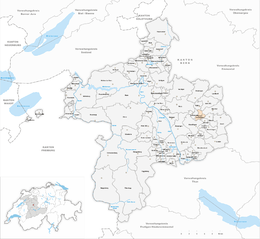Grosshöchstetten
| Grosshöchstetten | |
|---|---|
 |
|
| Coordinates: 46°54′N 7°38′E / 46.900°N 7.633°ECoordinates: 46°54′N 7°38′E / 46.900°N 7.633°E | |
| Country | Switzerland |
| Canton | Bern |
| District | Bern-Mittelland |
| Area | |
| • Total | 3.46 km2 (1.34 sq mi) |
| Elevation | 745 m (2,444 ft) |
| Population (Dec 2015) | |
| • Total | 3,516 |
| • Density | 1,000/km2 (2,600/sq mi) |
| Postal code | 3506 |
| SFOS number | 0608 |
| Surrounded by | Arni, Biglen, Konolfingen, Mirchel, Oberthal, Schlosswil, Zäziwil |
| Twin towns | Zirovnice (Czech Republic) |
| Website |
www SFSO statistics |
Grosshöchstetten is a municipality in the Bern-Mittelland administrative district in the canton of Bern in Switzerland.
Grosshöchstetten is first mentioned in 1146 as Honsteten. Until 1896 it was known as Höchstetten.
The oldest trace of a settlement in the area are two La Tene graves which were discovered in the Buchelhüsli and Hürnbergacker area. During the Late Middle Ages the portions of the village and surrounding fields were owned by a variety of nobles. Eventually much of the village was incorporated in the Herrschaft of Signau. The village church was first mentioned in 1230, though it was built over the foundation of an 11th-century building. After Bern adopted the Protestant Reformation in 1528, the church came under Bernese patronage. In the same year the Herrschaft of Wil acquired the village from Signau and in 1534 it was fully incorporated into Wil. The current village church was built in 1811.
The town was located at the intersection of the Bern-Lucerne and Burgdorf-Thun roads and was an important stop on these major routes. Because of its location, in 1834, Grosshöchstetten became a market town. In 1839, a dairy and cheese factory opened in the town. In 1899 the major roads were supplemented by the Burgdorf-Thun Railway, which raised Grosshöchstetten into a more important regional transportation hub. In 1830 the Konolfingen district recorder's office was moved to Grosshöchstetten where it remained for 17 years. A secondary school opened in the town in 1856 and a hospital, which became a district hospital, opened in 1879. Beginning in the 1870s craftsmen and factories began to settle in the town. In 1901 a biscuit factory opened, which remained in operation until 1970. In the 1960s a second wave of industrialization swept through the town and an anodizing factory, several appliances companies and construction companies settled in Grosshöchstetten. This second wave of industrialization caused the population to grow and many new houses were built.
...
Wikipedia



